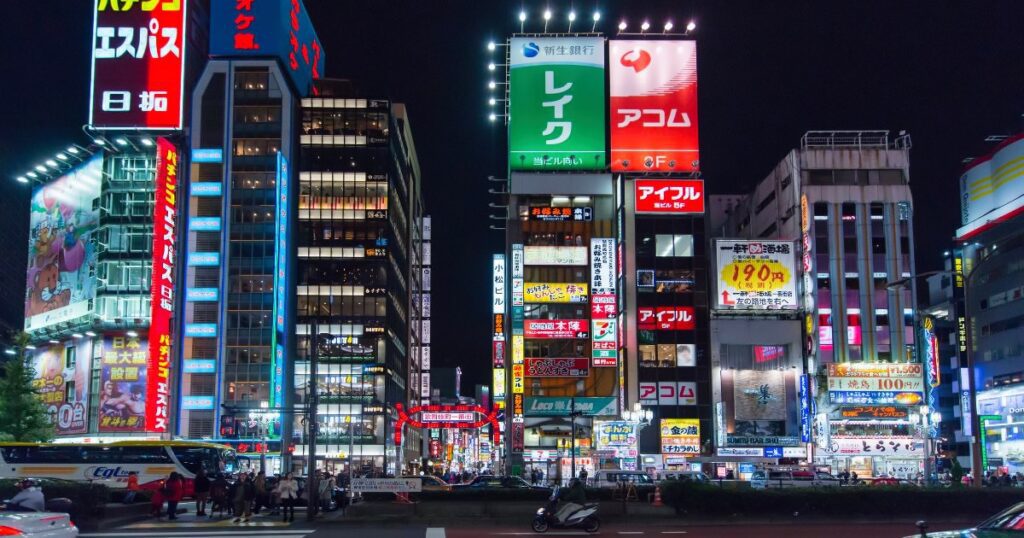Welcome to a journey into the heart of Tokyo’s dynamic energy – it’s about vibrant Tokyo red-light districts. From Kabukicho’s neon-lit avenues to Roppongi’s upscale nightlife, these areas offer a captivating mix of history, culture, and entertainment. But they’re more than just spots of intrigue and fun; they are cultural landmarks telling intriguing stories of Japan’s social evolution.
This blog post aims to unpack these narratives, highlighting the districts’ unique charm and significance. Through this exploration, we’ll not only deepen our understanding of Tokyo’s cultural fabric, but we’ll also discover the universal human themes echoed in such districts worldwide. So, let’s uncover the fascinating world within Tokyo’s red-light districts together.
Table of Contents
History of Tokyo’s Red-Light District:
Tokyo’s red-light districts, like the famously illuminated Kabukicho in Shinjuku and the internationally known Roppongi, have a rich and layered history that spans centuries. These areas’ evolution has been shaped by social changes, government regulations, and shifting societal attitudes towards the world’s oldest profession.
In the early days, during the Edo period (1603-1868), pleasure quarters were established outside city boundaries to entertain the thriving merchant class. Yoshiwara, located in what is now Tokyo’s Taito City, was the most famous of these districts. This licensed pleasure quarter was known for its courtesans, or “oiran,” who were the pinnacle of Edo-era entertainment, offering art, music, dance, and companionship.
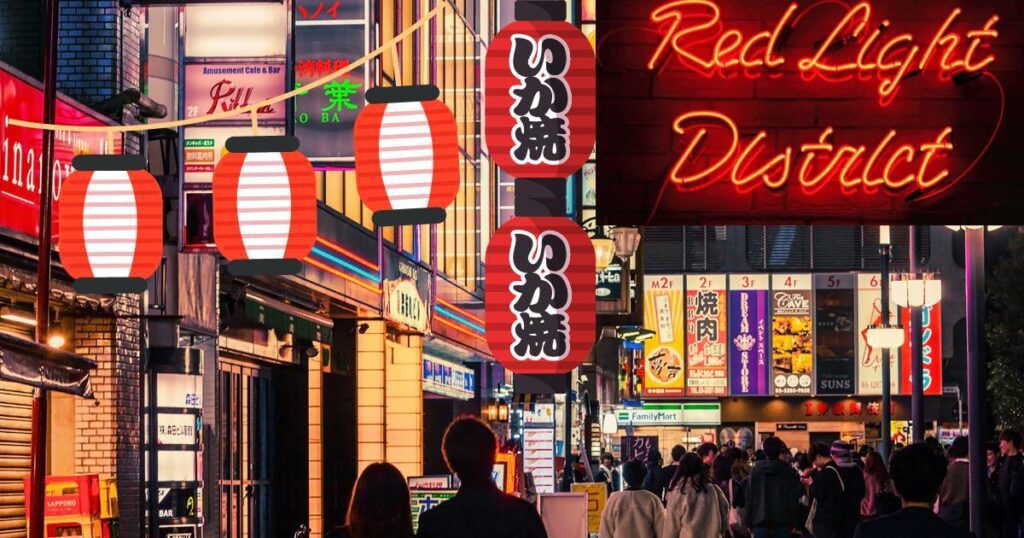
Tokyo underwent significant transformations following World War II, and the pleasure districts were no exception. Kabukicho, once a residential area, became Tokyo’s most famous red-light district. It grew quickly during the post-war economic boom, when it became known for its nightlife, packed with bars, clubs, and “pink salons.”
Over the years, societal attitudes have continued to evolve, leading to shifts in the operations within these districts. The introduction of the Anti-Prostitution Law in 1956 altered the landscape, pushing certain activities underground and creating businesses offering services in grey areas of the law.
Today, Tokyo’s red-light districts remain a paradox of tradition and modernity, legality and the underworld, and glamour and grit. The unique cultural significance of these districts is a testament to their enduring place in Japan’s evolving narrative.
Key Areas:
Tokyo, a city of striking contrasts, is home to several notable red-light districts, each showcasing its unique character and allure. Here, we will explore two of the most famous areas: Kabukicho Red Light District in Shinjuku and Roppongi.
1) Kabukicho:
Kabukicho, often called “the city that never sleeps,” lies in the heart of Shinjuku. Once the sun sets, this district comes alive with the glow of neon lights, the bustle of eager visitors, and the allure of the unknown. This area is renowned for its broad spectrum of entertainment options.
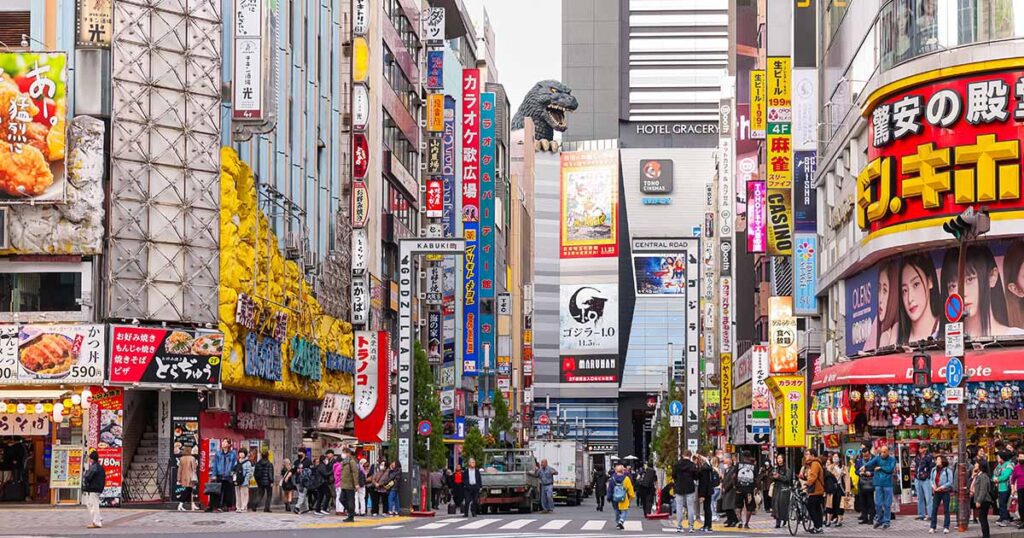
You’ll find everything from restaurants to bars. Amid the risque establishments, Kabukicho also houses the Robot Restaurant, a riotous fusion of Japanese pop culture, lasers, and enormous robots. For movie buffs, the iconic Toho Cinemas, marked by the towering figure of Godzilla, provide a thrilling cinematic experience. Despite its reputation, Kabukicho has evolved over the years into a relatively safe area frequented by both locals and tourists seeking nocturnal entertainment.
2)Roppongi:
On the other hand, Roppongi, located in Minato City, is Tokyo’s cosmopolitan hub, attracting an international crowd with its sleek clubs, high-end restaurants, and art scene. Known for its more upscale vibe, Roppongi’s nightlife is diverse. The district houses everything from popular nightclubs and foreigner-friendly bars to the Roppongi Hills, a sprawling complex with a shopping center, hotel, and art museum. Despite its glitzy appeal, Roppongi has its share of adult-orientated businesses, similar to Kabukicho.
Each district presents a unique facet of Tokyo’s red-light culture. Kabukicho’s chaotic charm contrasts starkly with Roppongi’s polished glamour, reflecting the vast range of experiences that these areas offer. Despite their notorious reputations, they continue to be essential parts of Tokyo’s vibrant nightlife, embodying the city’s ceaseless energy and complexity.
Cultural Significance:
Red-light districts like those in Tokyo are not merely areas of adult entertainment; they are profound cultural landmarks. Their cultural significance is woven into various art, literature, and popular culture aspects.
Firstly, these districts have inspired various forms of art. From woodblock prints in the Edo period to contemporary films and photography, their vivid scenes have been captured and portrayed in various media. This impact on art reflects the compelling narratives these districts embody.
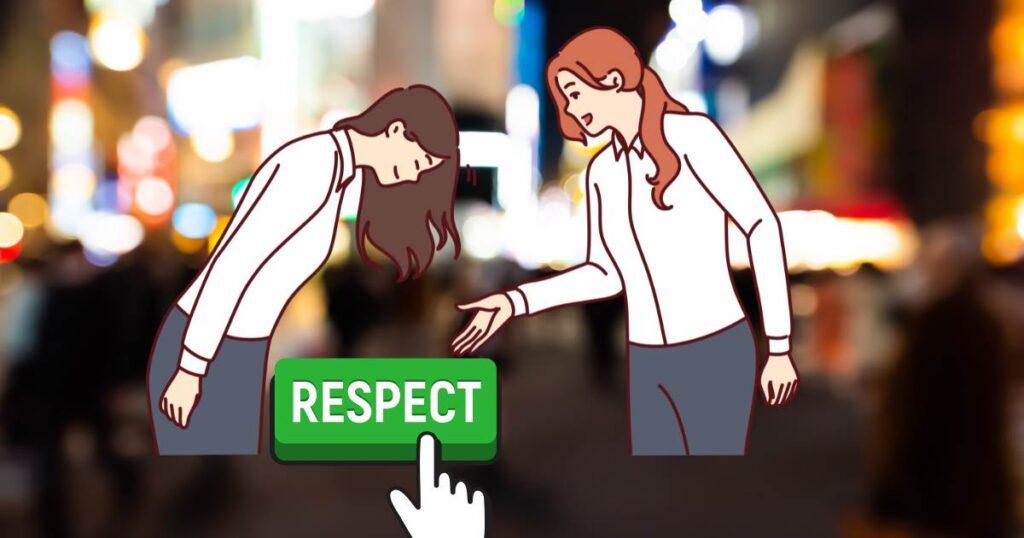
Secondly, red-light districts have been central settings in literature and movies. For instance, many Japanese films and novels have used these areas as their backdrop, painting a nuanced picture of life within their bounds. This has contributed to a better understanding and representation of these districts in Japanese society.
In popular culture, Tokyo’s red-light districts often serve as symbols of the city’s vibrant nightlife. Their neon lights, bustling streets, and unique establishments have become iconic images of Tokyo, seen in numerous travel guides and television programs.
For locals, these districts are part of their city’s identity. While some view them with disdain due to the associated vices, others see them as integral parts of their history and urban life. For tourists, these districts often evoke intrigue and curiosity, offering an unfiltered glimpse into Japan’s complex social dynamics.
Overall, the cultural importance of red-light districts lies in their ability to reveal a city’s multiple dimensions. They provide insight into societal attitudes, history, and local customs, making them significant not only for their entertainment value but also for their cultural resonance.
Legal & Social Aspects:
Tokyo’s red-light districts operate within a complex framework of laws and social norms. Understanding these aspects can provide a clearer picture of how these areas function.
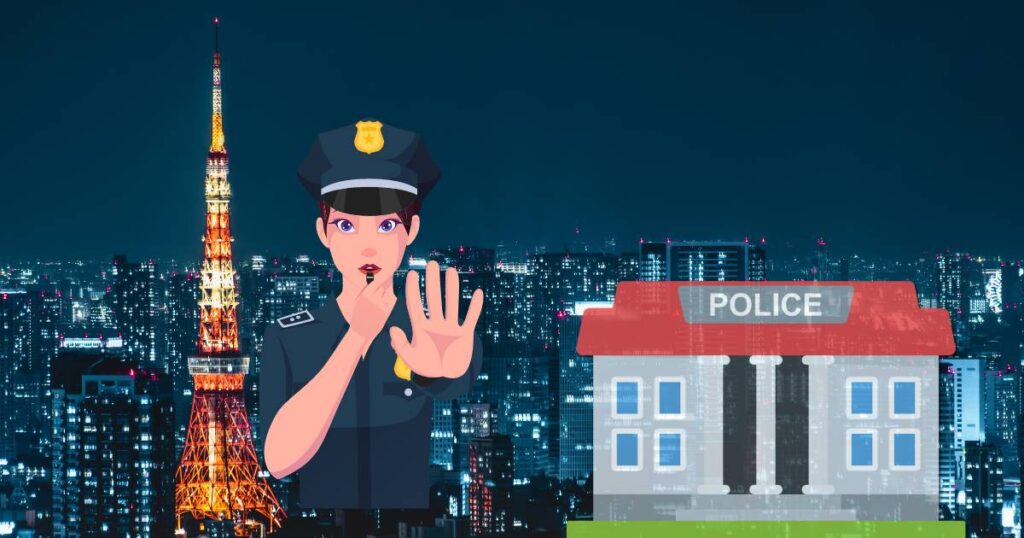
Societal attitudes towards Tokyo’s red-light districts have evolved. In the past, they were often seen as taboo and associated with criminal activities. But over the years, there has been a shift in perception.
Nowadays, while still controversial, these areas are more accepted as part of Tokyo’s urban landscape and nightlife.
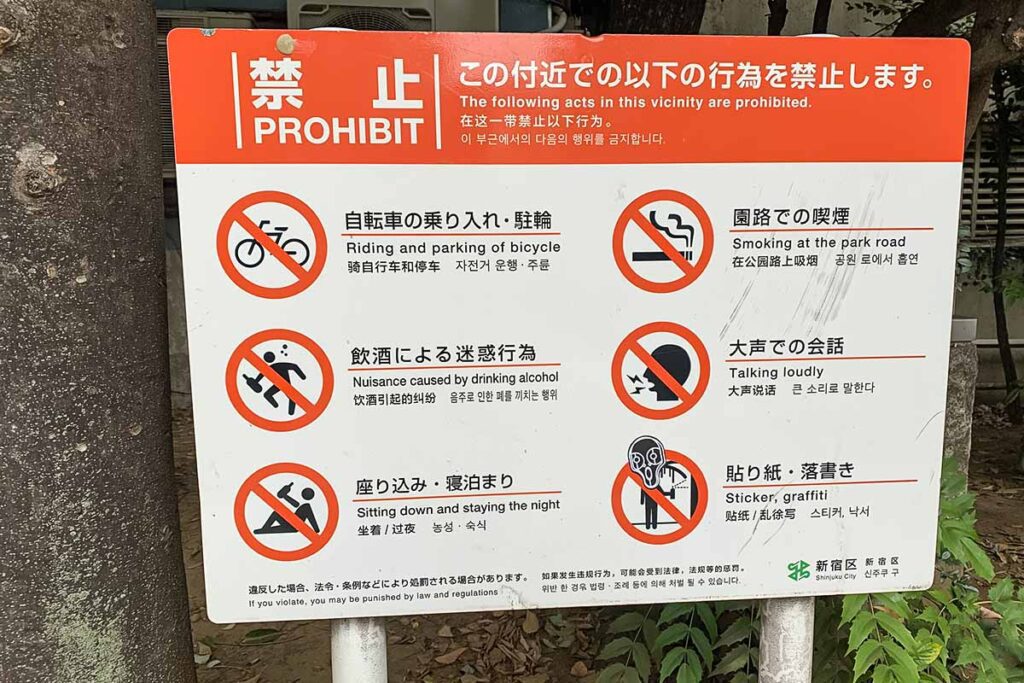
However, it’s important to remember that red-light districts continue to be a complex topic in Japanese society, with ongoing debates about legality and morality. These discussions reflect the larger social attitudes and are part of the ongoing evolution of these districts.
Visitor’s Guide:
Embarking on a journey through Tokyo’s red-light districts promises to be a captivating adventure that offers glimpses into the city’s vibrant nightlife and intriguing subcultures. Here are a few helpful tips to ensure that your visit is memorable, respectful, and safe.
1. Understand Before You Go:
First, take a moment to research the areas you plan to visit. Understanding the unique characteristics of districts like Kabukicho or Roppongi can help set your expectations and ensure you maximize your visit.
2. Respect Local Norms:
Remember, these districts are more than tourist attractions; they are part of the city’s living, breathing cultural fabric. Respect the local norms, be polite, and maintain a low profile. Do not take photos without permission, especially of the people and establishments.
3. Stay Legal:
Familiarize yourself with Japanese laws regarding adult entertainment. Certain activities may fall into legal grey areas, so staying informed and avoiding any potentially unlawful situations is crucial.
4. Be Cautious of Scams:
Like any nightlife area worldwide, be aware of potential scams. Keep an eye on your belongings, avoid too-good-to-be-true offers, and always know the cost of services before agreeing to anything.
5. Explore with Friends:
If possible, explore these areas in groups. It’s not only safer but also more fun. If you’re a solo traveler, consider taking a tour guide.
6. Experience the Spectrum of Entertainment:
The red-light districts are not just about adult services; they also offer plenty of other forms of entertainment. Try out the diverse food joints, enjoy a film at the iconic Toho Cinemas in Kabukicho, or visit the high-end Roppongi Hills complex for shopping and art.
Remember, the goal of your visit should be to appreciate the unique cultural aspects of these districts. Respectful and lawful engagement ensures a positive experience for you, the workers, and the local community. Embark on this adventure with an open mind, and let Tokyo’s vibrant red-light districts leave you with unforgettable memories.
Experiences:
Having called Tokyo home for nearly a decade, my relationship with its red-light districts has grown and evolved. Places like Kabukicho and Roppongi are more than just spots on a map for me – they’re part of the city’s heartbeat, and visiting them has become a regular part of my life.
When I first ventured into Kabukicho, the city’s largest red-light district, it was a whirl of neon lights, bustling crowds, and a palpable sense of energy. Over time, I’ve found there’s so much more to it. I’ve wandered down its countless alleys, discovering hidden gems like small izakayas where locals gather after work, the thrilling spectacle of the Robot Restaurant, and even quiet spots where the city’s frantic pace seems to slow down a bit. These experiences have shown me Kabukicho’s multifaceted personality.
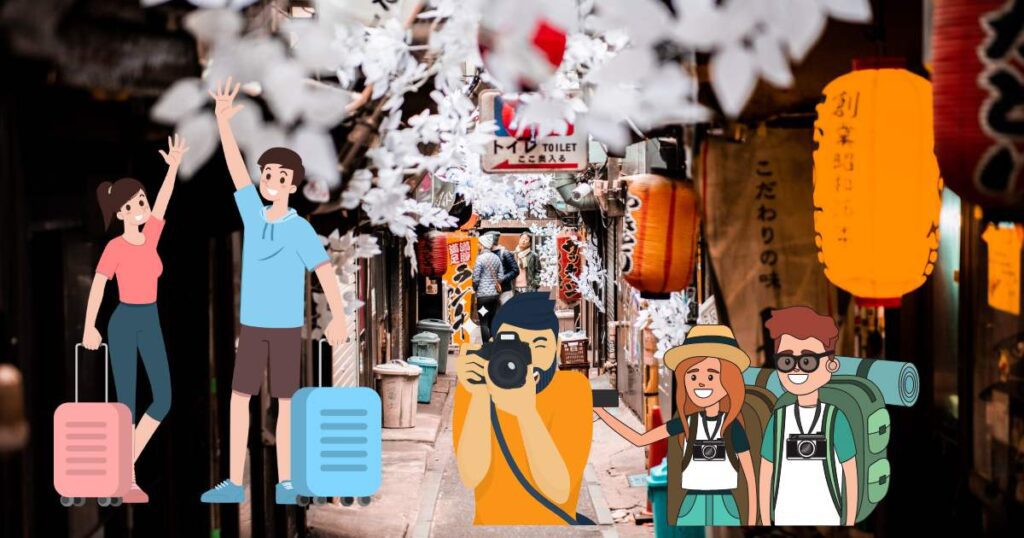
Roppongi, on the other hand, has a different feel. The district’s upscale clubs and high-end restaurants make it a go-to spot for a night out. My visits to the Roppongi Art Museum and the panoramic views from Roppongi Hills always remind me of the area’s unique blend of modernity and art.
Over the years, I’ve learned to navigate these districts easily, going beyond the tourist trails and finding my own rhythm. But even as a long-time resident, these districts continue to surprise me. Each visit brings something new – a just-opened bar, an unexpected street performance, or a fascinating conversation with a local.
For me, the red-light districts of Tokyo represent the city’s dynamic and complex character. They are places of contrast, where every turn can bring a new discovery. And though they may not be everyone’s cup of tea, I believe they offer valuable insights into Tokyo’s rich cultural tapestry. As a long-term resident, these experiences have deepened my understanding and appreciation of the city I now call home.
Final Thoughts:
In conclusion, Tokyo’s red-light districts, notably Kabukicho and Roppongi, are vibrant tapestries of history, culture, and entertainment. They are places of contrast and discovery, where the city’s past and present converge. From their deep-rooted history to their modern-day evolution, these districts offer a unique lens through which to view the city’s complexity.
Whether you’re a first-time visitor, a curious tourist, or a long-time resident like me, Tokyo’s red-light districts offer an experience unlike any other. These areas are a testament to the city’s unceasing energy and ability to continuously redefine itself. While they may be contentious for some, there’s no denying their cultural significance and unique place in Tokyo’s urban landscape.
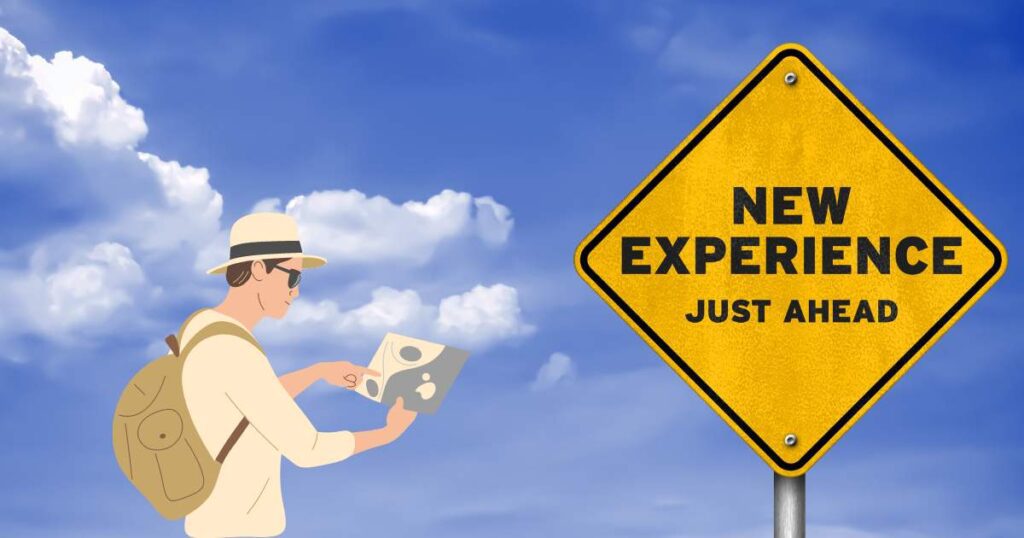
I hope this blog has given you a deeper understanding of Tokyo’s red-light districts. But remember, nothing beats the experience of exploring these areas for yourself. So, the next time you come to Tokyo, why not venture into these districts and see what they offer?
As always, I welcome your thoughts, experiences, and discussions. What are your impressions of Tokyo’s red-light districts? Please share in the comments below, and let’s start a conversation!
In the end, whether we view these districts through a lens of controversy or fascination, their presence continues to add color and intrigue to the enigmatic city of Tokyo.
FAQ:
How to get To Akihabara from Shinjuku?
Take Sobu Line, which takes only 17 minutes, and get off at Akihabara (See here).
Where is the red-light district in Tokyo?
Tokyo, Japan’s bustling capital, houses several red-light districts within its vast expanse. The most well-known of these is Kabukicho, located in the Shinjuku Ward. Known as the “Sleepless Town,” Kabukicho is a neon-lit hub of entertainment, dining, and nightlife. Another notable area is Roppongi, an upscale district famous for its vibrant nightlife and foreign-friendly establishments.
Is Tokyo’s red-light district foreigner-friendly?
While Tokyo’s red-light districts are primarily designed to cater to locals, they can still offer a fascinating experience for foreigners. Many establishments in these districts are foreigner-friendly, particularly in areas like Roppongi, known for its cosmopolitan atmosphere. However, not all venues accept non-Japanese customers due to language barriers and cultural differences. It’s always a good idea to research or ask ahead before visiting these places.
What is the biggest red-light district in Tokyo?
The biggest red-light district in Tokyo is Kabukicho in Shinjuku. This bustling area is home to a vast array of establishments, including bars, restaurants, nightclubs, love hotels, and various adult entertainment venues. Kabukicho’s neon-lit streets, buzzing nightlife, and unique charm make it a must-visit for those seeking to experience Tokyo’s vibrant nightlife.
What is the most famous red-light district in Japan?
While Tokyo’s Kabukicho is arguably the most well-known red-light district in Japan due to its size, visibility, and the variety of entertainment it offers, there are other famous red-light districts across the country as well. For instance, Yoshiwara, located in Tokyo, has a rich historical significance dating back to the Edo period. Fukuoka’s Nakasu and Osaka’s Tobita Shinchi also hold a significant place in Japan’s red-light culture. Each of these districts offers a unique slice of Japanese nightlife, reflecting the cultural nuances of their respective regions.
